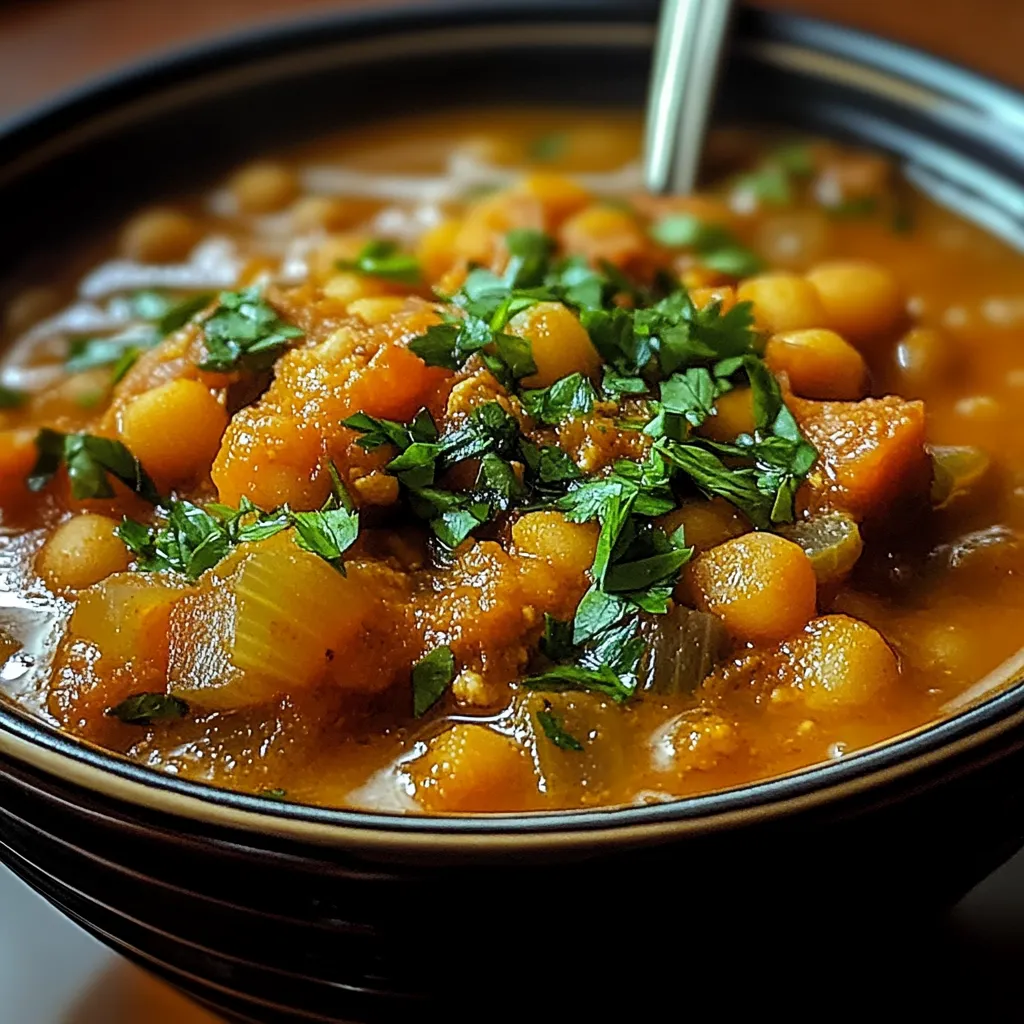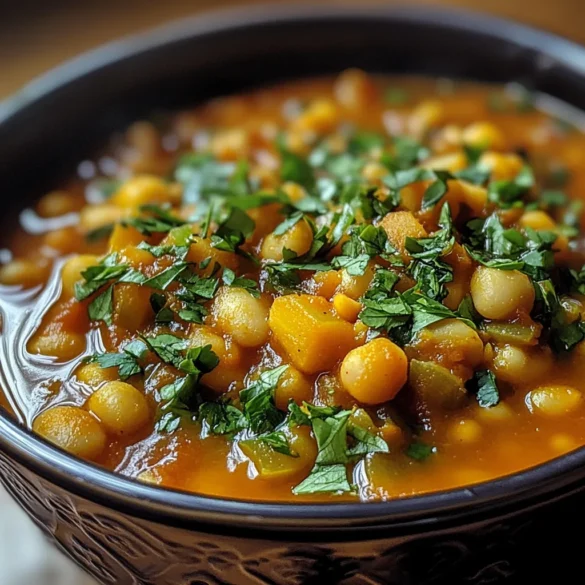This irresistible Moroccan Harira transforms humble lentils, chickpeas, and tomatoes into an exotic, soul-warming soup with its perfect balance of warming spices, tender legumes, and fresh herbs that embodies the rich culinary traditions of North African cuisine. The recipe showcases the beautiful complexity of Moroccan flavors, featuring protein-rich red lentils and chickpeas, aromatic vegetables, and a carefully balanced spice blend that includes turmeric, cinnamon, and ginger, all simmered in a rich tomato base that creates depth and satisfaction. Every spoonful delivers an exquisite harmony—the earthy lentils and chickpeas provide satisfying protein and substance, while the warming spices create layers of complex flavor that transport you to the bustling souks of Marrakech, and the fresh cilantro and parsley add bright, herbaceous notes that balance the rich, warming base. The soup’s visual appeal of golden-orange color flecked with vibrant green herbs and tender legumes makes it as beautiful to behold as it is nourishing to consume. This versatile comfort food exemplifies Moroccan hospitality at its finest—ideal for Ramadan breaking fasts, cold weather comfort, exotic dinner parties, or anytime you crave an authentic, aromatic soup that effortlessly brings together ancient spice traditions in the most satisfying, culturally rich way possible.
Why You’ll Love This Recipe
- Authentic Moroccan flavors: Captures traditional North African spice combinations
- Nutritional powerhouse: Packed with protein-rich legumes and vitamins
- Warming spice blend: Features exotic spices that provide comfort and health benefits
- Traditional Ramadan staple: Perfect for breaking fasts or special occasions
- Vegan-friendly option: Naturally plant-based and satisfying without meat
- Make-ahead convenience: Tastes even better the next day as flavors develop
- Budget-conscious: Uses affordable pantry staples for economical meals
- Healing properties: Offers digestive benefits from ginger and warming spices
- Cultural experience: Provides authentic taste of Moroccan home cooking
- Freezer-friendly: Stores well for convenient future exotic meals
Ingredients
For the Aromatic Spice Base
- Yellow onions – Create sweet, caramelized foundation
- Celery stalks – Add classic aromatic depth and texture
- Fresh ginger – Provides warming spice and digestive benefits
- Garlic cloves – Contribute essential aromatic complexity
- Ground turmeric – Adds golden color and anti-inflammatory properties
- Ground cinnamon – Provides warm, sweet spice characteristic of Moroccan cuisine
- Ground ginger – Enhances warming spice profile
- Saffron threads – Optional luxury spice for authentic flavor and color
- Olive oil – Used for sautéing and Mediterranean authenticity
For the Rich Tomato and Legume Base
- Crushed tomatoes – Form the rich, tangy soup foundation
- Red lentils – Provide protein and creamy texture when cooked
- Chickpeas – Add substantial protein and satisfying texture
- Vegetable or chicken broth – Creates flavorful liquid base
- Tomato paste – Intensifies tomato flavor and adds depth
- Harissa paste – Optional for authentic heat and complexity
- Bay leaves – Add subtle earthy background flavor
- Salt and black pepper – Balance and enhance all flavors
For the Fresh Herb Finish
- Fresh cilantro – Provides bright, citrusy herb notes
- Fresh parsley – Adds fresh, grassy flavor and vibrant color
- Fresh lemon juice – Brightens all flavors and adds acidity
- Green onions – Contribute mild onion flavor and fresh crunch
- Fresh mint – Optional for additional aromatic freshness
Optional Enhancements
- Lamb or beef – Traditional protein for non-vegetarian version
- Rice or small pasta – Add extra substance and authenticity
- Preserved lemons – Provide authentic Moroccan flavor complexity
- Ras el hanout spice blend – Traditional Moroccan spice mixture
- Fresh tomatoes – Add during summer for peak flavor
- Roasted red peppers – Contribute smoky sweetness
- Dates – Add subtle sweetness traditional in some regions
- Pine nuts – Provide textural contrast and richness
- Different legumes – Experiment with black-eyed peas or fava beans
Step-by-Step Instructions
Building the Aromatic Spice Foundation
- Begin by heating 3 tablespoons of olive oil in a large, heavy-bottomed pot or Dutch oven over medium heat, creating the foundation for developing the complex Moroccan flavor profile through proper spice blooming.
- Add 2 diced yellow onions and 3 chopped celery stalks to the hot oil, cooking for 6-8 minutes until the vegetables soften and the onions become golden and fragrant, stirring occasionally to prevent burning.
- Add 1 tablespoon freshly grated ginger and 4 minced garlic cloves to the softened vegetables, cooking for 1-2 minutes until aromatic, stirring constantly to prevent the garlic from burning and becoming bitter.
- Add the spice blend: 2 teaspoons ground turmeric, 1 teaspoon ground cinnamon, 1 teaspoon ground ginger, ½ teaspoon black pepper, and a pinch of saffron threads (if using), stirring constantly for 30 seconds to bloom the spices.
- Add 2 tablespoons of tomato paste to the spiced vegetables and cook for 1-2 minutes, stirring constantly to caramelize the paste and develop deeper, richer flavors that form the soup’s foundation.
- If using harissa paste, add 1-2 teaspoons now, adjusting to your heat preference and stirring to incorporate evenly throughout the aromatic base mixture.
Creating the Rich Tomato and Legume Base
- Add 1 can (28 oz) of crushed tomatoes to the pot, stirring to combine with the spiced vegetable mixture and scraping up any browned bits from the bottom for maximum flavor development.
- Pour in 6 cups of vegetable or chicken broth, 1 cup of red lentils (rinsed and drained), and 1 can (15 oz) of drained and rinsed chickpeas, stirring to combine all ingredients evenly.
- Add 2 bay leaves and 1½ teaspoons of salt to the pot, then bring the mixture to a boil over high heat before reducing to medium-low heat for gentle simmering.
- Cover and simmer for 25-30 minutes until the red lentils break down and create a creamy, thick consistency while the chickpeas become tender and the flavors meld beautifully together.
- Stir the soup occasionally during cooking to prevent sticking and ensure even cooking, adding more broth or water if the soup becomes too thick for your preference.
- Taste and adjust seasonings after the lentils have cooked, adding more salt, pepper, or spices as needed to achieve the authentic Moroccan flavor balance you desire.
Adding Final Elements and Fresh Herbs
- If including rice or small pasta for extra substance, add ⅓ cup during the last 15 minutes of cooking, ensuring it’s fully cooked and tender before proceeding to the next step.
- Remove the bay leaves from the soup and stir in ½ cup chopped fresh cilantro and ½ cup chopped fresh parsley, reserving some herbs for garnishing the finished bowls.
- Add 2-3 tablespoons of fresh lemon juice to brighten all the flavors and provide the acidic balance that’s essential to authentic Harira, tasting and adjusting as needed.
- If using additional fresh elements like chopped green onions or fresh mint, fold them in gently during the last few minutes to maintain their fresh texture and bright flavors.
- Allow the soup to rest off the heat for 5 minutes to let all the flavors settle and integrate fully before serving, creating the most harmonious and authentic taste experience.
Traditional Serving and Presentation
- Ladle the hot Harira into traditional ceramic bowls or rustic serving vessels, ensuring each portion contains a good balance of legumes, vegetables, and aromatic broth.
- Garnish each bowl generously with additional fresh cilantro and parsley, a squeeze of fresh lemon juice, and perhaps a drizzle of good olive oil for authentic Moroccan presentation.
- Serve alongside traditional accompaniments such as dates, dried figs, or small sweet pastries, which provide the sweet contrast that’s traditional during Ramadan breaking of fasts.
- Provide lemon wedges, extra harissa paste, and additional fresh herbs at the table, allowing diners to customize their bowls according to personal preferences and heat tolerance.
- For the most authentic experience, serve with traditional Moroccan bread or flatbread for dipping and sopping up the flavorful broth, creating a complete cultural dining experience.
- Store any leftover Harira in the refrigerator for up to 4 days, noting that the flavors will continue to develop and often taste even better the following day.

Pro Tips
- Bloom spices in oil to release maximum flavor and aroma
- Use fresh ginger rather than dried for best warming properties
- Rinse lentils before adding to prevent foaming during cooking
- Don’t skip the tomato paste caramelization step for depth
- Adjust liquid consistency throughout cooking as lentils absorb broth
- Add fresh herbs at the end to maintain bright, vibrant flavors
- Taste and adjust spicing as Moroccan cuisine emphasizes balance
- Use saffron if available for authentic color and flavor
- Allow soup to rest before serving for flavor integration
- Garnish generously with fresh herbs for traditional presentation
- Provide lemon wedges for individual brightness adjustment
- Use high-quality harissa for authentic heat and complexity
- Consider overnight soaking for dried chickpeas for better texture
- Layer seasonings throughout cooking for complex flavor development
- Serve with traditional accompaniments for cultural authenticity
- Store properly as flavors improve with time
- Adjust consistency when reheating as legumes continue absorbing liquid
- Use fresh herbs liberally as they’re essential to authentic flavor
- Consider regional variations in spicing for personal preference
- Embrace the aromatic qualities that make this soup special
Variations and Creative Ideas
Regional Moroccan Variations
- Casablanca Style: Add small pieces of lamb or beef during the initial sautéing stage for the traditional meat version that’s popular in urban areas, cooking the meat until browned before adding vegetables.
- Fez Traditional: Incorporate vermicelli noodles or broken angel hair pasta during the last 10 minutes of cooking for the classic Fassi variation that adds satisfying substance and traditional texture.
- Atlas Mountain Style: Include white beans alongside chickpeas and add extra warming spices like black pepper and ginger for the heartier mountain version that provides more calories for cold climates.
- Coastal Variation: Add diced preserved lemons and extra fresh herbs for the lighter coastal style that emphasizes bright, fresh flavors influenced by Mediterranean proximity.
Seasonal Adaptations
- Summer Fresh Version: Incorporate fresh tomatoes, zucchini, and extra fresh herbs during peak growing season for lighter variation that celebrates summer garden abundance and fresh flavors.
- Winter Warming Comfort: Add extra root vegetables like carrots and turnips, plus warming spices like cloves and cardamom for cold-weather version that provides maximum comfort and warmth.
- Spring Green Enhancement: Include fresh peas, fava beans, and spring onions for seasonal variation that celebrates new growth and provides bright, fresh flavors after winter.
- Autumn Harvest Style: Incorporate pumpkin or butternut squash cubes and add sweet spices like allspice for fall variation that celebrates harvest season and provides natural sweetness.
Dietary Modifications
- Gluten-Free Assurance: Ensure all ingredients including broth and spices are certified gluten-free, making this naturally gluten-free soup safe for celiac diets without compromising flavor.
- Low-Sodium Version: Reduce added salt and rely on spices, lemon juice, and fresh herbs for flavor enhancement, making the soup suitable for those monitoring sodium intake.
- Protein-Enhanced: Add extra legumes like black-eyed peas or kidney beans for higher protein content that appeals to athletes and those following high-protein diets.
- Keto-Adapted: Reduce legumes and add more vegetables like cauliflower and zucchini for lower carbohydrate version that maintains Moroccan flavors while fitting ketogenic requirements.
Modern Fusion Ideas
- Mediterranean Fusion: Add olives, artichoke hearts, and feta cheese for Greek-inspired variation that combines North African spices with Mediterranean ingredients for unique fusion appeal.
- Indian Spice Influence: Include curry powder, garam masala, and coconut milk for Indian-Moroccan fusion that creates exotic flavor combinations and creamy richness.
- Mexican-Moroccan: Add black beans, corn, and jalapeños with Mexican spices for southwestern fusion that bridges two spice-loving culinary traditions with exciting results.
- Italian-Moroccan: Include cannellini beans, fresh basil, and Parmesan cheese for Italian-inspired variation that combines rustic Italian flavors with Moroccan spice complexity.
Frequently Asked Questions
What makes authentic Harira different from other lentil soups?
Authentic Harira is distinguished by its specific spice blend (turmeric, cinnamon, ginger), the combination of red lentils and chickpeas, fresh herb finish, and its cultural significance as a Ramadan soup. The texture should be somewhat thick from broken-down lentils, and the flavor profile balances warming spices with bright fresh herbs. The addition of tomatoes and the particular aromatic base of onions, celery, and ginger create its distinctive character.
How can I adjust the spice level for different preferences?
Harira’s heat traditionally comes from black pepper and optional harissa paste. Start with smaller amounts and adjust gradually—you can always add more but can’t remove spice. For mild versions, omit harissa and reduce black pepper. For heat lovers, increase harissa and add cayenne pepper. Fresh ginger provides warmth without heat, while dried chili flakes offer controllable spiciness. Serve extra harissa on the side for individual customization.
Why do my lentils turn mushy or don’t break down properly?
Red lentil texture depends on cooking time and liquid ratios. For proper breakdown, ensure you’re using red lentils (which naturally break down) rather than green or brown varieties. Simmer gently rather than boiling vigorously, which can make them mushy too quickly. If they’re not breaking down enough, cook longer and mash some against the pot sides. Old lentils take longer to cook, so check your lentil freshness for best results.

Ingredients
For the Aromatic Spice Base:
- 2 yellow onions, diced
- 3 celery stalks, chopped
- 1 tablespoon fresh ginger, grated
- 4 garlic cloves, minced
- 2 teaspoons ground turmeric
- 1 teaspoon ground cinnamon
- 1 teaspoon ground ginger
- ½ teaspoon black pepper
- Pinch of saffron threads (optional)
- 3 tablespoons olive oil
- 2 tablespoons tomato paste
- 1-2 teaspoons harissa paste (optional)
For the Rich Tomato and Legume Base:
- 1 can (28 oz) crushed tomatoes
- 1 cup red lentils, rinsed
- 1 can (15 oz) chickpeas, drained and rinsed
- 6 cups vegetable or chicken broth
- 2 bay leaves
- 1½ teaspoons salt
For the Fresh Herb Finish:
- ½ cup fresh cilantro, chopped
- ½ cup fresh parsley, chopped
- 2-3 tablespoons fresh lemon juice
- 2 green onions, chopped (optional)
- 2 tablespoons fresh mint, chopped (optional)
For Garnish and Serving:
- Extra fresh herbs
- Lemon wedges
- Extra virgin olive oil
- Traditional Moroccan bread or flatbread
- Dates or dried figs (traditional accompaniment)
Instructions
- Heat olive oil in large pot over medium heat. Sauté diced onions and celery 6-8 minutes until softened.
- Add grated ginger and minced garlic, cook 1-2 minutes until fragrant.
- Add turmeric, cinnamon, ground ginger, black pepper, and saffron. Stir 30 seconds to bloom spices.
- Add tomato paste and harissa if using, cook 1-2 minutes stirring constantly.
- Add crushed tomatoes, scraping up any browned bits from bottom of pot.
- Add broth, red lentils, chickpeas, bay leaves, and salt. Bring to boil.
- Reduce heat to medium-low, cover, and simmer 25-30 minutes until lentils break down.
- Stir occasionally and add more liquid if needed for desired consistency.
- Remove bay leaves. Stir in half the fresh cilantro and parsley.
- Add lemon juice and taste for seasoning adjustments.
- Let rest 5 minutes off heat. Serve hot with remaining herbs as garnish.
Notes
- Bloom spices in oil to release maximum flavor and aromatic compounds
- Use fresh ginger rather than dried for best warming properties and taste
- Rinse red lentils before adding to prevent excessive foaming during cooking
- Don't skip the tomato paste caramelization step for maximum depth
- Adjust liquid consistency throughout cooking as lentils absorb significant broth
- Add fresh herbs at the end to maintain bright, vibrant flavors and color
- Taste and adjust spicing as Moroccan cuisine emphasizes perfect balance
- Use saffron if available for authentic color and distinctive flavor
- Allow soup to rest before serving for optimal flavor integration
- Garnish generously with fresh herbs for traditional, authentic presentation
- Provide lemon wedges for individual brightness and acidity adjustment
- Use high-quality harissa paste for authentic heat and flavor complexity
- Consider overnight soaking for dried chickpeas for superior texture
- Layer seasonings throughout cooking process for complex flavor development
- Serve with traditional accompaniments for complete cultural authenticity
- Store properly as flavors continue to improve with time
- Adjust consistency when reheating as legumes continue absorbing liquid
- Use fresh herbs liberally as they're essential to authentic Moroccan flavor
- Consider regional spicing variations for personal preference adaptation
- Embrace the aromatic qualities that make this soup truly special and distinctive

